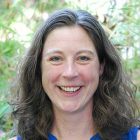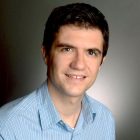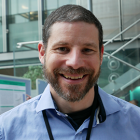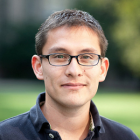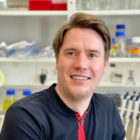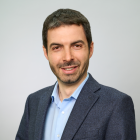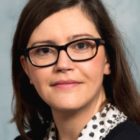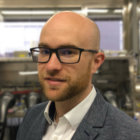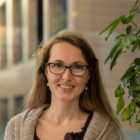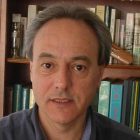Sascha Hoogendoorn (President)
Department of Organic Chemistry, UNIGE
Sascha Hoogendoorn lab aims to study and perturb cellular signalling, with a particular interest in the primary cilium and the Hedgehog signalling pathway. Her research combines organic chemistry with cell biology and CRISPR/Cas9-based gene editing to develop molecules that enable further dissection and manipulation of ciliary signalling.
Beat Fierz (Vice-President)
Chemical Sciences and Engineering, EPFL
Beat Fierz lab focuses on the study of the structure, dynamics and function of chromatin and related multi-protein complexes in vitro and in cells. These investigations require an interdisciplinary approach at the interface of chemistry, biology and biophysics.
Robbie Loewith (Treasurer)
Department of Molecular Biology & Cellular biology, UNIGE
The Loewith lab investigates the structures, functions and regulation of the two, broadly conserved, target of rapamycin (TOR) protein complexes. They use a combination of yeast genetics, cell biology, structural biology, chemical biology and biochemistry approaches and are particularly interested in how TOR complexes form higher order helical structures and how they are regulated downstream of mechanical changes in membrane tension.
Pablo Rivera-Fuentes
Laboratory of Chemical and Biological Probes, University of Zurich
Pablo Rivera-Fuentes lab, draws from the fields of organic synthesis, molecular biology, protein engineering, single-molecule imaging, and artificial intelligence to develop small-molecule and protein tools to study the subcellular compartementalization of biological processes. Current research lines in our lab include the characterization of the redox states of mammalian organelles, the creation of chemigenetic markers and sensors for in vivo imaging, and the development of single-molecule peptide and protein identification technologies.
Andreas Boland
Department of Molecular Biology & Cellular biology, UNIGE
The Boland lab aims to study the molecular mechanisms that underlie cell cycle regulation as well as signal transduction by membrane proteins in health and diseasework at the intersection of Structural Biology, Molecular & Cell Biology and Chemical Biology. Their research leverages the latest developments in cryogenic electron microscopy (cryoEM) and uses complementary biophysical techniques (proteomics, light-microscopy, microfluidics, etc.).
Alessandro De Simone
Department of Genetics and Evolution, UNIGE
De Simone’s lab is interested in the physical principles underlying vertebrate regeneration. His group uses high-sensitivity sensors and reporters to visualise signals, forces and cell dynamics as well as analyse data using automated quantification methods.
Anne-Claude Gavin
CMU, University of Geneva
Pioneering in the development of novel (bio)chemical methods to map cellular protein-lipid interaction networks, the Gavin group has a strong research interest in the study of lipid metabolism and the regulation of cellular membranes homeostasis, with a special focus on the machinery involved in the creation and maintenance of lipid gradients in eukaryotic cells, and the study of mechanisms by which lipid signatures are sensed and “read” by effector proteins.
Pierre Gönczy
School of Life Sciences, EPFL
Pierre Gönczy’s main research interests lie in understanding fundamental cell division processes, notably in the context of a developing organism and with a focus on the mechanisms governing centriole biogenesis and centrosome duplication as well as asymmetric cell division, a crucial phenomena for generating cellular diversity during development and in stem cell lineages.
Nathalie Grob
Department of Chemistry and Applied Biosciences, ETHZ
About Nathalie Grob The Grob Group focuses on designing and screening potential therapeutic modalities that address common challenges faced by […]
Christian Heinis
Chemical Sciences and Engineering, EPFL
The ultimate goal of Christian Heinis lab is the development of therapeutics by developing peptide macrocycles for potential therapeutic application using phase based strategy and biological and chemical tools. His lab currently develops potent antagonists to a range of disease targets, following medical indications in which bicyclic peptides promise advantages over small molecules and monoclonal antibodies.
Kathrin Lang
Department of Chemistry and Applied Biosciences, ETH Zurich
Lang’s general research interests strive to develop new tools to study and control biological systems. Her group is especially active in enabling and advancing approaches to expand the genetic code and in developing new in vivo chemistries that are amenable to physiological conditions. This combination is ideally suited to address unmet challenges in studying and manipulating biological processes with a new level of spatial, temporal and molecular precision.
Sophie Martin
Dept. of Molecular and Cellular Biology , UNIGE
Sophie Martin lab aims to understand in molecular detail how cells polarize, organize their cytoskeleton and their membrane to achieve growth, division and fusion. To this end, they use a combination of quantitative live-cell imaging, electron microscopy, genetic and biochemical approaches.
Ross Milton
Department of Inorganic and Analytical Chemistry, UNIGE
Research in the Milton Group seeks to couple metalloenzymes that catalyze important reductive reactions to electrodes, in order to study their electron transfer/catalytic mechanisms and ultimately aid the development of new biotechnologies (and bio-inspired technologies).
Aurélien Roux
Biochemistry Department, UNIGE
Aurélien Roux main research interest explores the common biological and mechanical mechanisms by which surfaces formed by cell monolayers or lipid bilayers are deformed during physiological processes such as membrane traffic, endocytosis, cell-division, cell migration and others.
Milena Schuhmacher
School of Life Sciences, EPFL
The Schuhmacher Lab is interested in answering outstanding questions in membrane biology. Their chemical biology approach opens the door to investigate the so far mostly invisible and thus secret work of lipids. In particular, they would like to understand the biological role of lipid diversity and their impact on signaling processes.
Angela Steinauer
Institute of Chemical Sciences and Engineering, EPFL
Angela Steinauer’s lab focuses on the engineering of non-viral, protein-based nanocarriers for targeted RNA delivery. Inspired by viral nucleic acid-protein assemblies, her group adopts a bottom-up approach and utilizes protein design, biomolecular engineering, and directed evolution to construct carriers with tailored functionalities.
Nicolas Thomä
ISREC – Swiss Institute for Experimental Cancer Research
The Thomä lab focuses on the structure and function of macromolecular machines at the interface of chromatin biology and ubiquitin biology. Recent work from the laboratory illustrated how transcription factor operate in the context of chromatin, and how endogenous and synthetic small molecules drive the degradation of transcription factors and other cellular proteins by leveraging the ubiquitin proteasome system.
Gerardo Turcatti
BSF ACCESS, EPFL
The Academic Chemical Screening platform of Switzerland (ACCESS), led by Gerardo Turcatti, provides the scientific community with chemical diversity, screening facilities, medicinal chemistry and know-how in chemical genetics.
Jérôme Waser
Laboratory of Catalysis and Organic Synthesis, EPFL
The principal focus of the research conducted by the Waser group is the development and application of new catalytic methods for the synthesis of bioactive compounds. His lab harnesses the power of modern catalysis to promote C-C or C-X bond formation, allowing for a rapid and efficient enhancement in molecular complexity.
Nicolas Winssinger
Department of Organic Chemistry, UNIGE
The Winssinger lab makes use of small molecules and chemistry techniques to probe biological mechanisms. To accelerate probe discovery, the lab has pioneered DNA-encoded library technologies and has extended this technique to fold peptides in constricted conformations and are applying this approach to mimic affinity proteins. Their research has also pioneered proximity-enabled chemistries and used it to image oligonucleotides in cellulo or in vivo, turn-on drugs in response to biomarkers and more generally develop methodology for logic-gated responses. As part of this program, the Winssinger lab is developing photocatalytic reactions in chemical biology and using bioluminescence as a light source for photochemistry.

